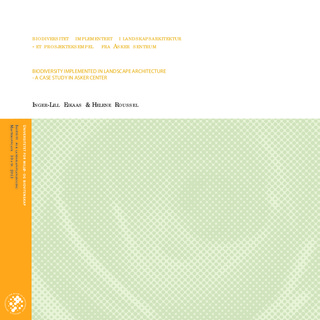| dc.description.abstract | Norsk: Mer enn halvparten av jordens befolkning bor i urbane områder og tallet øker kraftig. Samtidig er vi vitner til den største utryddelsen av arter siden dinosaurene døde ut for 65 millioner år siden. Det er i hovedsak menneskelig aktivitet som truer det biologiske mangfoldet gjennom tap, forringelse og fragmentering av habitat. Urbanisering og fortetting reduserer fragmentering av habitat, men dette går ofte på bekostning av grøntområdene. Denne oppgaven utforsker muligheter for å ivareta biologisk mangfold i et presset urbant område. Tematikken er høyst akuell, men får for lite oppmerksomhet innen fagfeltet landskapsarkitektur til tross for landskapsarkitekters posisjon til direkte påvirkning av omgivelsene.
Oppgaven presenterer først anvendt kunnskap om biodiversitet i urbane områder, og deretter omsettes kunnskapen til en verktøykasse bestående av fem deler: landskapsøkologiske prinsipper, menneskers preferanser i forhold til urban natur, tiltak for biodiversitet, artsvalg og vegetasjonsmodeller. Her legges det frem konkrete funn som ulike planters betydning for andre arter og hvordan man kan tilrettelegge for biodiversitet i grøntanlegg. Videre følger en analyse av Asker kommune før verktøykassen anvendes konseptuelt på prosjekteksempelet Asker sentrum. Avslutningsvis følger en diskusjon av oppgaven med hensyn på problemstillingen der det påpekes en brist i kunnskapsformidling samt nødvendigheten av større grad av tverrfaglig samarbeid.
English:
More than half of the world’s population is now living in urban areas and the number is constantly increasing. At the same time we are witnessing the greatest extinction of species since the dinosaurs died 65million years ago. It is mainly human activity that is causing this threat to loss of biodiversity through loss, degrading and fragmentation of habitat. Urbanization and densification reduces fragmentation of habitat, but this is often at the expence of the green areas. This thesis is exploring how to maintain biodiversity in urban areas under pressure. The topic is highly relevant, but rarely receive attention within the field of landscape architecture, despite the landscape architects position to directly shape the environments.
The thesis first presents utilized knowledge on biodiversity in urban areas and then the knowledge is put into a toolbox divided into five parts: landscape ecological principles, human preferences in urban nature, measures to enhance biodiversity, selection of species and models of vegetation. Here it is presented specific findings like plants different significance for other species and how to enhance biodiversity in a green area. Afterwards comes an analysis of Asker municipality before the toolbox is applied conceptually in the case study in Asker center. At the end follows a discussion of the whole thesis focused on the research question, where a shortcoming is addressed in the flow of knowledge, in addition to the necessity of greater interdisciplinary collaboration. | no_NO |
